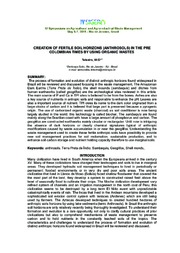Creation of fertile soil horizons (anthrosols) in the pre colombian times by using organic wastes.
Creation of fertile soil horizons (anthrosols) in the pre colombian times by using organic wastes.
Autoria: TEIXEIRA, W. G.
Resumo: The process of formation and evolution of distinct anthropic horizons found widespread in Brazil will be reviewed and discussed focusing in the waste management. The Amazonian Dark Earths (Terra Preta de Índio), the shell mounds (sambaquis) and ditches from human earthworks (called geoglifos) are the archeological sites reviewed in this article. The main source of P and Ca in TPI sites is believed to be from the bones. Ashes are also a key source of nutrients in antropic soils and responsible to enhance the pH. Leaves are also a important source of nutrient. TPI owes its name to the dark color originated from a large stocks of carbon and it is believed that large part is preserved because a pyrogenic origin. The use of carbonized organic waste (charcoal) as soil conditioner is now being largely studied in the world, this technology is called biochar. The sambaquis are found mainly along the Brazilian coast with have a large amount of phosphorus and carbon. The geoglifos are constructed earthworks mainly circular or rectangular. Until now is intriguing the absence of dark horizons or clearly chemical signatures typical of anthropic modifications caused by waste accumulation in or near the geoglifos. Understanding the waste management used to create these fertile anthropic soils have possibility to provide new soil management practices for soil reclamation, sustainable production, and to enhance soil carbon storage and nutrient holding capacity therefore to use marginal soils.
Ano de publicação: 2015
Tipo de publicação: Artigo em anais e proceedings
Unidade: Embrapa Solos
Palavras-chave: Antrossolo, Geoglifos, Sambaquis, Terra Preta de Índio
Observações
1 - Por padrão são exibidas publicações dos últimos 20 anos. Para encontrar publicações mais antigas, configure o filtro ano de publicação, colocando o ano a partir do qual você deseja encontrar publicações. O filtro está na coluna da esquerda na busca acima.
2 - Para ler algumas publicações da Embrapa (apenas as que estão em formato ePub), é necessário ter, no celular ou computador, um desses softwares gratuitos. Sistemas Android: Google Play Livros; IOS: iBooks; Windows e Linux: software Calibre.
Acesse outras publicações
Acesse a Base de Dados da Pesquisa Agropecuária (BDPA) para consultar o acervo completo das bibliotecas da Embrapa.

